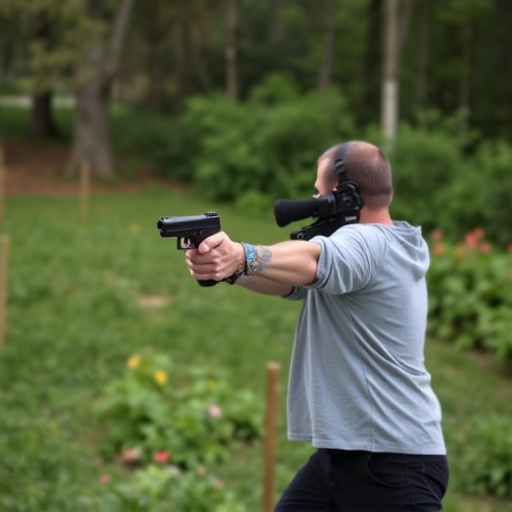Tasers and stun guns are non-lethal weapons with distinct applications: tasers disrupt muscle control from a distance, while stun guns emit high-voltage shocks upon direct contact. Bulk stun guns are popular among retailers for personal protection, but their effectiveness can be impacted by weather, armor, and distance. When stocking bulk stun guns, prioritize safety and legal compliance through reputable manufacturers, stay informed about local laws, and implement best practices like training sessions and spare parts availability. Retailers can enhance security by investing in bulk stun guns, deterring threats, and providing staff/customer protection.
“In the realm of personal safety and law enforcement, Tasers and stun guns stand as powerful tools, yet distinct in their applications. This comprehensive guide aims to demystify these devices by examining their unique capabilities and addressing key differences. From understanding the technology behind each to exploring legal considerations, we delve into what makes Tasers and stun guns suitable for various scenarios, especially when Bulk Stun Guns are considered for retail stores. Get ready to navigate this crucial topic with a well-informed perspective.”
- Understanding Tasers and Stun Guns: A Comprehensive Overview
- Key Differences Between Taser and Stun Gun Technology
- Bulk Stun Guns for Retail Stores: Considerations and Best Practices
- Legal Implications and Safety Precautions for Tasers and Stun Guns
Understanding Tasers and Stun Guns: A Comprehensive Overview

Tasers and stun guns are both non-lethal weapons designed to incapacitate an individual through electric shock, but they differ significantly in their functionality and applications. Tasers, officially known as Electronic Control Devices (ECDs), fire two thin probes connected to wires that deliver a high-voltage, low-current electrical pulse to the target’s body, disrupting muscle control and causing temporary paralysis. This makes tasers highly effective for law enforcement and self-defense purposes, as they can subdue an attacker without causing serious harm.
Stun guns, on the other hand, are simple hand-held devices that emit a strong electric charge from their surface when activated. Unlike tasers, stun guns do not require probes to make contact with the target; instead, they rely on the electrical current flowing through their outer casing to shock and disable the person holding or touching them. Stun guns are popular among individuals seeking personal protection and are often sold in bulk for retail stores, catering to those looking to safeguard themselves or their properties. However, their effectiveness can be limited by weather conditions, body armor, and distance, making them best suited for close-quarters defense.
Key Differences Between Taser and Stun Gun Technology

Tasers and stun guns are both non-lethal weapons designed to incapacitate individuals, but they operate on different principles. Tasers use electrical pulses to disrupt muscle control, causing the target to fall to the ground. This technology is known for its accuracy and ability to stop a resistant individual with minimal risk to bystanders. In contrast, stun guns emit a high-voltage, low-current electric discharge that causes severe pain and temporary paralysis. Stun guns are often more accessible and cheaper than tasers, making them popular choices for personal protection and bulk stun guns for retail stores.
While both weapons aim to subdue an attacker, their effects differ significantly. Tasers have a longer range and can be used from a distance, making them ideal for law enforcement scenarios. Stun guns, on the other hand, require direct contact or close proximity to deliver a shock, which can be advantageous in close-quarters encounters. The choice between a taser and a stun gun depends on factors such as intended use, budget, and personal preference.
Bulk Stun Guns for Retail Stores: Considerations and Best Practices

When considering bulk stun gun purchases for retail stores, several key considerations come into play to ensure customer safety and compliance with legal standards. The first is to choose products from reputable manufacturers that offer reliable performance and quality assurance. Stun guns vary significantly in power, range, and safety features, so understanding the differences between models is essential. Retailers should also stay updated on local laws and regulations regarding stun gun ownership and usage to avoid any legal complications.
Best practices include providing clear and comprehensive product information to customers, including safety instructions and guidelines for responsible use. Offering training sessions or workshops on stun gun usage can enhance customer confidence and ensure they understand the device’s capabilities and limitations. Additionally, maintaining a stock of spare parts and accessories, such as extra batteries or holsters, allows retailers to cater to customers’ needs and provide after-sales support.
Legal Implications and Safety Precautions for Tasers and Stun Guns

In understanding the differences between Tasers and stun guns, especially their applications in bulk for retail stores, it’s clear that each has unique advantages. While Tasers are known for their non-lethal force and ability to incapacitate targets with precise electrical pulses, stun guns offer a broader range of options and power levels. For retail stores considering the purchase of bulk stun guns, careful consideration of factors like user training, maintenance, and legal compliance is essential. By adopting these devices responsibly and strategically, businesses can enhance security without compromising safety.
